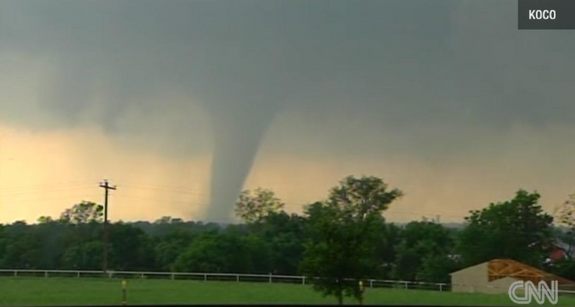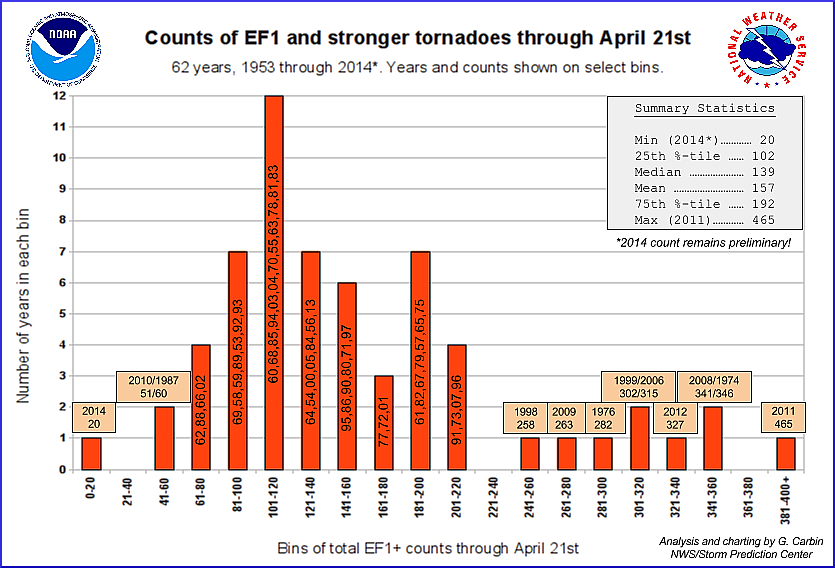Slowest Start to Tornado Season in a Century

A cold start to 2014 kicked off a quiet tornado season this year, which has seen the fewest twisters since 1915, according to preliminary National Weather Service (NWS) reports.
Notably, no one has died in a tornado so far this year — which represents another record in the modern tornado-tracking era, which started in 1950.
Through April 21, the United States had reported just 20 EF-1 tornadoes, said Harold Brooks, a senior researcher at the National Oceanic and Atmospheric Administration's National Severe Storms Laboratory in Norman, Okla. "My best guess is that this is the slowest start since 1915, and maybe even 1900," he said.
The average number of EF-1 tornados by this point in the year is 157, according to NWS statistics. Tornadoes are ranked on the "Enhanced Fujita" or EF damage scale, with 0 being the weakest and 5 being the strongest. The number of EF-1 tornadoes is a better way to compare each season than the number of EF-0 tornadoes, Brook said. That's because the number of EF-1 twisters has consistently hovered between 500 to 600 yearly for the past 60 years, while the weaker EF-0 tornadoes varied tremendously, from 50 to about 800 per year, he said. [The Top 5 Deadliest Tornado Years in U.S. History]
You can thank the lingering winter for quelling any powerful twisters. "We had three straight months of below-normal temperatures, and that meant fewer than normal tornadoes," Brooks told Live Science. However, a colder-than-normal summer means more tornadoes than normal, Brooks said.
The cold temperatures also meant Oklahoma finally got relief from its string of deadly tornadoes, with a tornado-free streak from Aug. 7, 2013, through April 13, 2014. The Norman, Okla., NWS office set a new record for its longest tornado-warning-free stretch on April 13, at 316 days. The previous streak was 293 days, set in 1991.
There have been no EF-3 or stronger tornadoes in the United States this year.
Get the world’s most fascinating discoveries delivered straight to your inbox.
But don't expect the pattern to continue, Brooks cautioned. "We've got ourselves a pretty reasonable chance of a significant tornado occurrence this weekend, so we could get closer to normal pretty quickly," he said.
Tornado frequency peaks in May, with a little more than half of the country's EF-1 twisters hitting in April, May and June. Weather patterns shift in spring — warm, moist air moves northward from the Gulf of Mexico and clashes with cold, dry air heading south. The colliding air masses often meet over the Southern Plains in April and the Northern Plains in June, giving rise to the sweeping storms that birth tornadoes.
And both 2012 and 2013 were below-average tornado years, though they both experienced deadly tornadoes. In 2013 — another year with a colder-than-average March in the Southeast — the Moore, Okla., EF-5 tornado killed 25 people and caused $2 billion in damage. In 2012, when drought parched much of the Plains, killer tornadoes ripped through Indiana and Kentucky.
"Just because it's been quiet doesn't mean it's going to stay quiet," Brooks said. "The beginning of the season tells us nothing about the rest of the season."
Email Becky Oskin or follow her @beckyoskin. Follow us @livescience, Facebook & Google+. Original article on Live Science.





